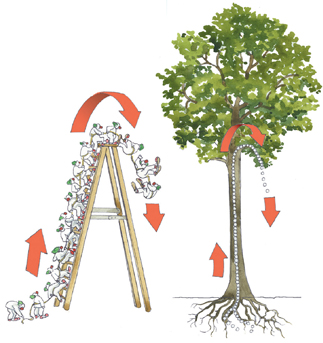23.5 Transport in Plants
 What are the major forces that transport water in a plant?
What are the major forces that transport water in a plant? What drives the movement of fluid through phloem tissue in a plant?
What drives the movement of fluid through phloem tissue in a plant?
adhesion • capillary action • pressure-flow hypothesis
Compare/Contrast Table As you read, create a table in which to compare and contrast the functions of xylem and phloem.
THINK ABOUT IT Look at a tall tree. Maybe there's one outside your school that's 15 meters high or even taller. Think about how much work it would be to haul water up to the top of that tree. Now think of a giant redwood, a hundred meters high. How does water get to the top?
Water Transport
 What are the major forces that transport water in a plant?
What are the major forces that transport water in a plant?
Recall that active transport and root pressure cause water to move from soil into plant roots. The pressure created by water entering the tissues of a root can push water upward in a plant stem. However, this pressure does not exert nearly enough force to lift water up into trees. Other forces are much more important.
Transpiration The major force in water transport is provided by the evaporation of water from leaves during transpiration. As water evaporates through open stomata, the cell walls within the leaf begin to dry out. Cell walls contain cellulose, the same material used in paper. As you know, dry paper towels strongly attract water. Similarly, the dry cell walls draw water from cells deeper inside the leaf. The pull extends into vascular tissue so that water is pulled up through xylem.
How important is transpirational pull? On a hot day, even a small tree may lose as much as 100 liters of water to transpiration. The hotter and drier the air, and the windier the day, the greater the amount of water lost. As a result of this water loss, the plant draws up even more water from the roots. Figure 23–19 shows an analogy for transpirational pull.
VISUAL ANALOGY
TRANSPIRATIONAL PULL

FIGURE 23–19 Imagine a chain of circus clowns who are tied together and climbing a tall ladder. When the first clown reaches the top, he falls off, pulling the clowns behind him up and over the top. Similarly, the chain of water molecules in a plant extends from the leaves down to the roots. As molecules exit leaves through transpiration, they pull up the molecules behind them.

Table of Contents
- Formulas and Equations
- Applying Formulas and Equations
- Mean, Median, and Mode
- Estimation
- Using Measurements in Calculations
- Effects of Measurement Errors
- Accuracy
- Precision
- Comparing Accuracy and Precision
- Significant Figures
- Calculating With Significant Figures
- Scientific Notation
- Calculating With Scientific Notation
- Dimensional Analysis
- Applying Dimensional Analysis




